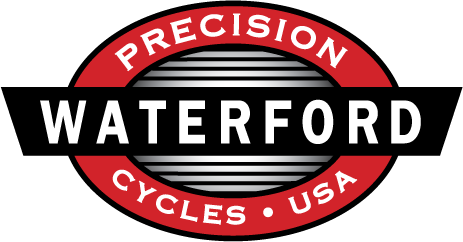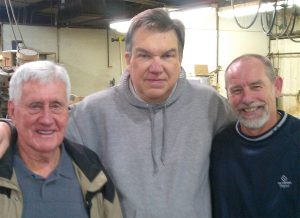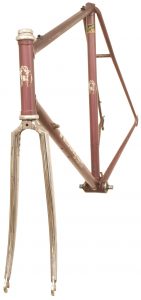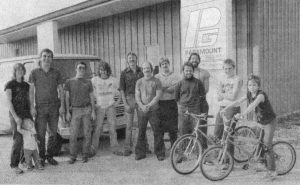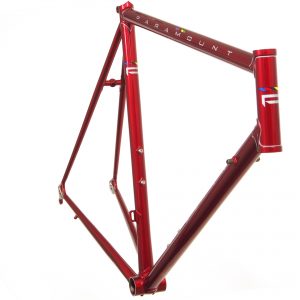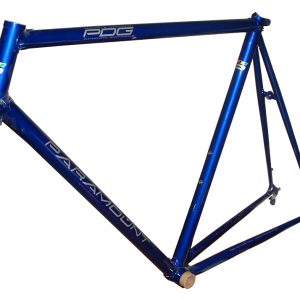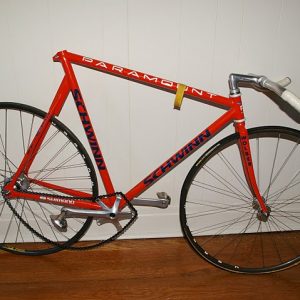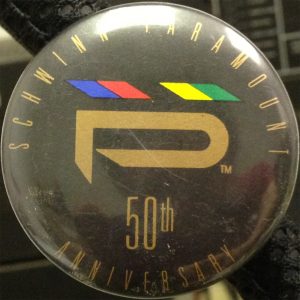During the early 70’s, the Paramount dominated the sales of American-built race bikes, though as the decade progressed, the market became increasingly turbulent. The bike boom dominated the first half of the decade, collapsing in late 1974. Paramount’s tooling, lugs and tubing had all become outdated. The key would be to bring in some new energy into the line.
That energy was to come from Marc Muller. Marc was one of those small builders who started up during the 1970’s. At the time he was the manager of a bike store in the west suburbs of Chicago. Marc had owned a 60’s Paramount as well as an Eisentraut. Marc, a craftsman by orientation, tried his hand at building his own frame as early as 1973 using parts he acquired from a Washington DC pro shop called Proteus.
That year he met up with Ron Boi, a Chicago area pro shop owner who had started to build his own frames. Through 1974 and 1975, Marc built a small number of frames using French firm Bocoma lugs. By ’76, Marc and Ron started bringing in Super Vitus tubing and Bocoma long point lugs which he then cut to a medium length. Marc’s bike, named for his dog Phydeaux, pioneered a unique fastback stay design and also used the Gargette Super bottom bracket shell.
His first sale was to local legend Babe Van de Velde (uncle of Vandedrome’s John Van de Velde). He continued his day job as a bike store manager through mid-1970’s. The shop, Severson’s, was one of Schwinn’s largest dealers. There he developed a relationship with Schwinn manager Bill Morris. Bill, a bit skeptical of how Schwinn approached its pro bike business, became intrigued with Marc’s work and views.
Marc finally struck out on his own in October, 1977. During 1978, Marc tested out some of the first of the pioneering Henry James investment-cast lugs and shells. By year-end the problems of business overcame his passion for building and he finally joined Schwinn’s Engineering department.
Marc had been approached by Schwinn on occasion to join the Paramount group. He wouldn’t accept just becoming one of the builders but he agreed to build frames are part of his job within the Engineering Department under Frank Brilando. His first Paramount, built for Schwinn spokesman Jean Claude Killy, was built at Phydeaux. Frank and Marc sized Killy’s frame by looking at a photograph of Killy on his current bike and scaling it to the at the time one inch top tube. The bike included lugs from Albert Eisentraut.
When Ed Schwinn took over the company in 1979, one of the first things he did was to shut down Paramount production. If it couldn’t be a world-class bike then don’t make one until it could.
Marc was put in charge of re-building Paramount – almost from scratch. He started out by retooling the department including a new brazing fixture and alignment table. In June of ’80, the company decided it needed the Paramount back but that they would have to move out of the Chicago factory. Marc’s first bikes were built for Eric Heiden and the 7/11 team in 1980.
That year, Schwinn brought back the Paramount as a super-custom bike – “anything you want” for the then outrageous sum of $3,000. These became known as the “Elite” Paramounts. By 1981, enough demand had built up to justify bigger plans. Marc got the go-ahead to build a factory which, after a considerable search, landed in Waterford, Wisconsin. The new factory housed what became Paramount Design Group, or PDG. Not simply a framebuilder, PDG was to become a design laboratory for both the re-born Paramount as well as the rest of Schwinn’s product lines. Frame production grew dramatically, matching all but the boom years of the early 70’s. In addition, PDG built the Sting, Schwinn’s high-end BMX race bike.
Marc got approval to begin using Columbus SL and SP tubing and Henry James’ next generation investment-cast lugs.
These bikes came with gold decals (the “Elite” set) and were built from 1981 through 1983.
From 1980 forward, Paramount became know as PDG for Paramount design group. Below is their first decal set – known as the “PDG Elite” – which ran from 1980 to 1983.
In 1983, Paramount shifted into more standardized production using the red-white-blue “Tri-Color” decal set. Long distance touring bikes dominated the production, though the factory enjoyed considerable growth in road racing bikes, as well.
By 1985 Paramount was in full gear, with what became the “standard” (and, accordingly, the “standard” decal set). For medium and smaller sizes, Paramount introduced Columbus SLX tubing. Road racing bikes came to dominate production.
As a design laboratory, PDG built many of the adult show bikes for Schwinn while developing a number of innovations. For the 1985 show, PDG presented a mountain bike with the first vertical dropouts and bent chainstays. By 1987, PDG exhibited bikes with 650C wheels. At the same show it presented it’s pioneering design with a 650C front wheel and a 700C rear wheel as well as aerodynamic moldings behind the head tube and seat tube. In 1988, PDG introduced the OS concept, by which frames could be built with larger diameters to gain stiffness with thinner and lighter cross-sections than before. In 1991, PDG presented the Schwinn Active Suspension System – SASS – a remarkable 4-bar linkage mountain bike rear suspension – the first with long (4″) travel and progressive damping. In 1992, PDG introduced its heated-treated OS tubeset.
OS Tubing
The development of the OS tube design began in 1987 with Marc Muller and then with the collaboration of Frank Brilando. It represented one of the most important innovations in bicycle tubing since the 1930’s. One aspect of the OS tubeset is now found on many bicycles – the 1 1/4″ downtube. 1 1/4″ in steel represents the best combination of overal strength to weight. Anything larger and there’s no way to make the wall thin enough to reduce weight without compromising the column strength of the tubing. Without adequate column strength the rider risks suffering a particular type of structural failure known as the “beer can effect”.
The OS tubeset included (and includes) much more:
The downtube enters the bottom bracket offset downward from the BB spindle by 5mm. This allows several important improvements to take place. First, it leaves more brazing surface area for both the downtube and the seattube.
The seatmast is flared at the bottom bracket. At first, Paramount flared it to 1 1/4″ at the bottom bracket. Waterford seattubes only flare to 30mm. This stiffens the area around the BB shell.
The chainstay tops out at 24mm at the bottom bracket instead of the traditional 22.2mm.
These changes strengthen the bottom bracket area – where it has the most impact on pedaling. The rest of the bike can be lightened up without compromising either stiffness or durability. These other changes involved creating a special lugset as well as a special tubeset. Waterford worked with True Temper to create its special tubeset.
The addition of the OS Paramount kept up demand for Paramounts even as the overall road racing market was collapsing. Paramount continued making the “Standard” (Columbus tubing) frames through late 1990, though the OS really took over. In 1992, PDG introduced the heat treated version of the OS tubeset. Heat treating allowed PDG to lighten up the tubeset still further.
During the early 1990’s, Schwinn began importing Paramount-branded bikes from Asia as part of an effort to grow Schwinn’s upper-end presence. This caused quite a bit of consternation among Paramount owners, who began to call their bikes Waterford Paramounts after the factory.
Later in 1992, PDG began developing the Reynolds 753 version of the OS tubeset. Reynolds 753 is the heat-treated version of its famous 531 tubeset. After years of experience Reynolds had developed the most consistent results from the use of OS tubing. Although 753 had been offered since the latter 1970’s, Schwinn’s brazers had never submitted to Reynolds certification tests. When they finally did in 1992, the results came back consistently as the finest examples of silver brazing in all their years of testing.
Updated PDG decal set for 1992.
When Schwinn was sold in 1993, a group of Schwinn employees bought the factory and started Waterford Precision Cycles (that’s, of course, another story). Waterford continued to build Paramounts pretty much as before the sale though the end of the 1993 model year. In 1994, Schwinn contracted with Waterford to build Paramounts – both for stock and on a custom basis.
753 tubing began to appear on Paramounts during the summer of 1993.
Schwinn decided to put the Paramount “to sleep” by September of 1994. They reintroduced the line in 1998 from other builders. Contact Schwinn directly for more information on these bikes.
